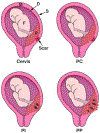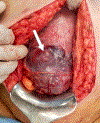New evidence-based diagnostic and management strategies for placenta accreta spectrum disorders
- PMID: 31126811
- PMCID: PMC6929563
- DOI: 10.1016/j.bpobgyn.2019.04.006
New evidence-based diagnostic and management strategies for placenta accreta spectrum disorders
Abstract
The increasing incidence of caesarean delivery (CD) has resulted in an increase in placenta accreta spectrum (PAS), adversely impacting maternal outcomes globally. Currently, more than 90% of women diagnosed with PAS present with a placenta praevia (praevia PAS). Praevia PAS can be reliably diagnosed antenatally with ultrasound, and it is unclear whether magnetic resonance imaging improves diagnosis beyond what can be achieved by skilled ultrasound operators. Therefore, any screening programme for PAS will require improved training in the diagnosis of placental disorders and development of targeted scanning protocols. Management strategies for praevia PAS vary depending on the accuracy of prenatal diagnosis, findings at laparotomy and local surgical expertise. Current epidemiological data for PAS are highly heterogeneous, mainly due to wide variation in the clinical criteria used to diagnose the condition at birth. This significantly impacts research into all aspects of the condition, especially comparison of the efficacy of different management strategies.
Keywords: Caesarean hysterectomy; Increta; Percreta; Placenta accreta; Prenatal diagnosis; Ultrasound imaging.
Copyright © 2019 Elsevier Ltd. All rights reserved.
Conflict of interest statement
The authors report no conflict of interest.
Figures



Similar articles
-
Prospective evaluation of impact of post-Cesarean section uterine scarring in perinatal diagnosis of placenta accreta spectrum disorder.Ultrasound Obstet Gynecol. 2022 Apr;59(4):474-482. doi: 10.1002/uog.23732. Epub 2022 Mar 8. Ultrasound Obstet Gynecol. 2022. PMID: 34225385 Free PMC article.
-
Third-trimester ultrasound for antenatal diagnosis of placenta accreta spectrum in women with placenta previa: results from the ADoPAD study.Ultrasound Obstet Gynecol. 2022 Sep;60(3):381-389. doi: 10.1002/uog.24889. Ultrasound Obstet Gynecol. 2022. PMID: 35247287 Free PMC article.
-
Ultrasound scoring system for prenatal diagnosis of placenta accreta spectrum.BMC Pregnancy Childbirth. 2023 Aug 7;23(1):569. doi: 10.1186/s12884-023-05886-x. BMC Pregnancy Childbirth. 2023. PMID: 37550654 Free PMC article.
-
Antenatal diagnosis of placenta accreta spectrum (PAS) disorders.Best Pract Res Clin Obstet Gynaecol. 2021 Apr;72:13-24. doi: 10.1016/j.bpobgyn.2020.06.010. Epub 2020 Jul 15. Best Pract Res Clin Obstet Gynaecol. 2021. PMID: 32747328 Review.
-
Systematic review and meta-analysis on placenta accreta spectrum disorders in twin pregnancies: risk factors, detection rate and histopathology.Minerva Obstet Gynecol. 2023 Feb;75(1):55-61. doi: 10.23736/S2724-606X.21.04886-7. Epub 2021 Jul 30. Minerva Obstet Gynecol. 2023. PMID: 34328297
Cited by
-
Caesarean Section Scar and Placental Location at the First Trimester of Pregnancy-A Prospective Longitudinal Study.Medicina (Kaunas). 2024 Apr 26;60(5):719. doi: 10.3390/medicina60050719. Medicina (Kaunas). 2024. PMID: 38792902 Free PMC article.
-
A multicenter observational survey of management strategies in 442 pregnancies with suspected placenta accreta spectrum.Acta Obstet Gynecol Scand. 2021 Mar;100 Suppl 1(Suppl 1):12-20. doi: 10.1111/aogs.14096. Acta Obstet Gynecol Scand. 2021. PMID: 33483943 Free PMC article.
-
Evaluation of the holding-up uterus technique for placenta accreta spectrum cesarean hysterectomy in shocked patients with a high shock index: a case series study.BMC Surg. 2024 Jan 13;24(1):23. doi: 10.1186/s12893-024-02311-8. BMC Surg. 2024. PMID: 38218800 Free PMC article.
-
Management and outcomes of women with placenta accreta spectrum grade 3: an INOSS multicountry multiperiod population-based study.BMC Pregnancy Childbirth. 2025 Apr 7;25(1):401. doi: 10.1186/s12884-025-07271-2. BMC Pregnancy Childbirth. 2025. PMID: 40197338 Free PMC article.
-
Placenta Percreta Previa Crossing Surgical Frontiers.Cureus. 2025 May 29;17(5):e85028. doi: 10.7759/cureus.85028. eCollection 2025 May. Cureus. 2025. PMID: 40585613 Free PMC article.
References
-
- Irving C, Hertig AT. A study of placenta accreta. Surgery, Gynecol Obstet 1937;64:178–200.
-
- Langhans T Die losung der muetterlichen eihaeute. Arch F Gynaek. 1875;8:287–97.
-
- Baisch K Zur pathologischen anatomie der placenta accreta. Arb Geb Pathol Anat Bact. 1907–1908;6:265–70.
-
- Luke RK, Sharpe JW, Greene RR Placenta accreta: The adherent or invasive placenta. Am J Obstet Gynecol 1966;95:660–8. - PubMed
Publication types
MeSH terms
Grants and funding
LinkOut - more resources
Full Text Sources
Medical

